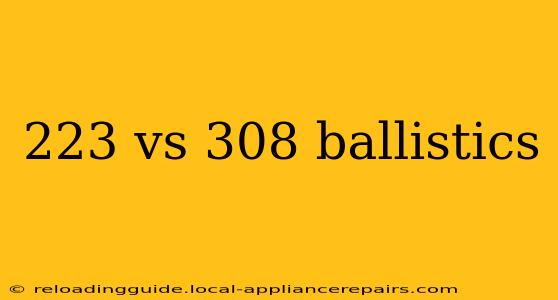Choosing the right caliber for your firearm is a crucial decision, impacting accuracy, range, and overall performance. This in-depth comparison of 223 Remington (5.56x45mm NATO) and 308 Winchester (7.62x51mm NATO) ballistics will help you understand the key differences and determine which caliber best suits your needs.
Key Ballistic Differences Between 223 and 308
The most significant difference lies in the cartridge size and resulting projectile weight and velocity. This impacts several key ballistic characteristics:
Projectile Size and Weight:
-
223 Remington: This smaller round typically uses projectiles ranging from 55 to 77 grains. The smaller diameter and lighter weight contribute to its higher velocity.
-
308 Winchester: Significantly larger, the 308 typically uses projectiles from 147 to 180 grains. The heavier projectile results in lower muzzle velocity but greater energy transfer.
Muzzle Velocity and Energy:
-
223 Remington: Boasts a much higher muzzle velocity, often exceeding 3000 fps (feet per second) depending on the barrel length and ammunition load. However, this higher velocity leads to a faster energy drop-off over distance.
-
308 Winchester: While having a lower muzzle velocity (typically around 2700 fps), the 308 maintains its energy far better at longer ranges due to the heavier projectile. This makes it a more effective round for longer-distance shooting.
Range and Accuracy:
-
223 Remington: Generally effective out to around 500 yards, but accuracy significantly degrades beyond that point. It's excellent for close-to-medium range engagements.
-
308 Winchester: Known for its superior accuracy and effectiveness at significantly longer ranges. Accurate shots are achievable out to 800-1000 yards and beyond with proper equipment and training.
Recoil:
-
223 Remington: Produces significantly less recoil than the 308, making it easier to handle, especially for newer shooters.
-
308 Winchester: The heavier projectile and larger cartridge result in noticeably greater recoil. This can be a challenge for inexperienced shooters and might require more robust rifles to manage.
Applications and Use Cases:
The ideal caliber depends heavily on the intended use:
223 Remington:
- Ideal for: Tactical shooting, varmint hunting (small animals like prairie dogs), target shooting at shorter ranges, and self-defense. Its lighter recoil and high velocity make it well-suited for rapid-fire situations.
308 Winchester:
- Ideal for: Hunting larger game animals (deer, elk, etc.), long-range target shooting, and precision shooting at extended ranges. Its greater energy retention at longer distances provides superior stopping power.
Choosing the Right Caliber: Considerations for Shooters
The decision between 223 and 308 depends entirely on your priorities. Consider these factors:
- Shooting distance: For shorter ranges, the 223 is a solid choice. For longer ranges, the 308 offers superior performance.
- Target or game: The size and type of target significantly influence the appropriate caliber.
- Experience level: Beginners might find the 223's lighter recoil easier to manage.
- Budget: Ammunition for both calibers is readily available, but the 308 tends to be slightly more expensive.
- Rifle platform: Both calibers are used in a wide variety of rifles, but some platforms are better suited to one caliber or the other.
Ultimately, the "better" caliber depends entirely on your individual needs and preferences. This detailed comparison should help you make an informed decision. Remember to always practice safe gun handling and consult with experienced shooters or firearm instructors for personalized advice.

